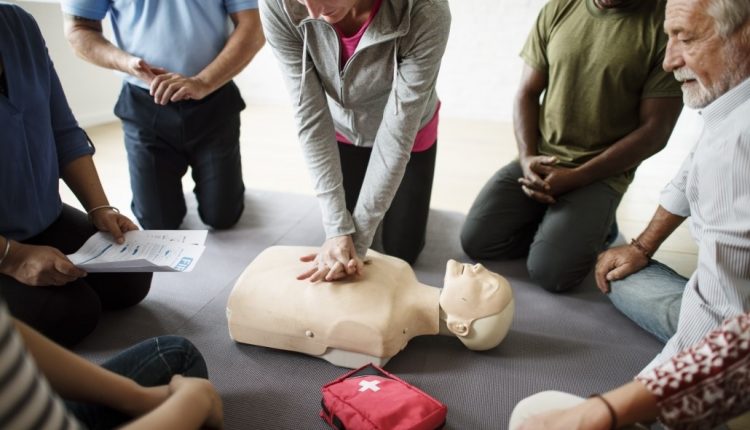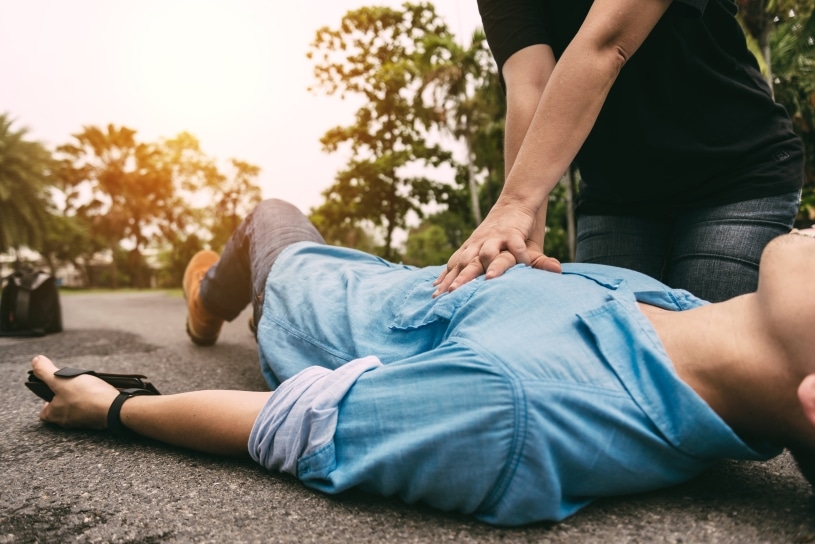
The 5 basic steps of CPR: how to perform resuscitation on adults, children and infants
Most people would be surprised to learn that nearly 45% of cardiac arrest victims survive thanks to the help of a bystander administering CPR
The truth is most cardiac arrests occur in public settings.
CPR is a critical skill and one that everyone should know
It can mean the difference between life and death for thousands of people yearly.
This is especially evident when you consider that only about 46% of people who experience a cardiac emergency will get the help they need before they receive professional medical attention.
By learning CPR, you could save a life
If you’ve ever considered signing up for CPR certification or BLS training, we’ve developed this simple “how to” CPR guide to inspire those considering formal training to take that next step.
If you’re already CPR certified, we hope you’ll use this article as a refresher on the basic steps necessary to perform this important, life-saving measure.
What Does CPR Stand For?
CPR stands for Cardiopulmonary Resuscitation.
CPR is an emergency procedure that can save a person’s life if their heart stops beating from sudden cardiac arrest.
Studies show that the chance of survival triples if CPR is performed right away!
What is Cardiac Arrest?
Just as it sounds, cardiac arrest is when the heart malfunctions and suddenly stops beating, often with little or no warning.
An electrical malfunction in the heart causes an irregular heartbeat or “arrhythmia.”
Cardiac arrest stops the heart’s pumping action so it cannot continue to pump blood to the brain, lungs, and other vital organs.
The victim loses consciousness within seconds of experiencing a cardiac arrest and exhibits no pulse.
Death can occur within minutes if the victim does not receive treatment.
What’s the Difference Between Cardiac Arrest, Heart Attack, and Heart Failure?
Cardiac arrest is when the heart malfunctions and suddenly stops beating. An “electrical” problem can often occur with an otherwise healthy heart.
Heart attack occurs when the blood flow to the heart is blocked, often by a blood clot or plaque buildup in the arteries. A heart attack is a “circulation” problem.
Heart failure means the heart is not pumping as well as it should be. It could be considered a “mechanical” or “functional” problem with the heart. Heart failure is usually the result of another disease, most commonly coronary artery disease.
How to Perform CPR
The American Heart Association (AHA) is a world leader in perfecting and teaching first aid and CPR and develops science-based guidelines for how to perform CPR properly.
The recommendations below are based on the 2015 American Heart Association (AHA) Guidelines Update for Cardiopulmonary Resuscitation (CPR) and Emergency Cardiovascular Care (ECC).
How to Perform CPR—For Rescuers with CPR Training
For healthcare providers and those trained in CPR: The technique is for conventional CPR, using chest compressions and mouth-to-mouth breathing at a ratio of 30:2 or two breaths for every 30 compressions.
For adult and teenage victims of cardiac arrest, rescuers should perform chest compressions at a relatively rapid rate of 100 to 120 compressions per minute and a chest compression depth of at least 2 inches (5 cm) for an average adult while avoiding chest compression depths greater than 2.4 inches (6 cm).
Be sure to allow complete recoil of the chest after each compression; do not lean on the chest after each compression.
For children (ages 1 year to puberty), compression depth should be about 2 inches (5cm). For infants (1 rescuer), the rescuer should use two fingers in the center of the chest, just below the nipple line.
Chest compression depth should be about 1 1/2 inches (4 cm).
How to Perform CPR—For Rescuers Without CPR Training
For non-healthcare providers or bystanders without formal CPR training: The recommendation for non-healthcare providers is for compression-only CPR, or hands-only CPR, without mouth-to-mouth breathing.
This version of CPR is recommended for civilians without formal training who happen to witness someone experiencing a cardiac emergency.
If you see a teen or adult suddenly collapse, it’s important to act fast and follow these steps for hands-only CPR:
Step 1: Check for Breathing
Check for signs of breathing—look for the chest rising and falling, or feel or hear the breath.
Step 2: Call Emergency Number
If the person is not breathing or is gasping, ask someone to call Emerency Number while you begin CPR, or call Emergency Number yourself and then start CPR.
Step 3: Adjust your Body to Perform Chest Compressions
Kneel next to the victim and use your fingers to locate the end of their breastbone, where the ribs come together.
Place two fingers at the tip of the breastbone, then place the heel of your other hand above your fingers (on the side closest to the victim’s face).
Next, put the heel of your other hand on top of the first hand so your hands are stacked (intertwining fingers is recommended).
Step 4: Perform Chest Compressions
Push hard and fast in the center of the chest until help arrives—remember, you are now pumping the blood through their body.
You can use the weight of your own body to add strength to your pushes. It’s important to administer 100 to 120 compressions per minute.
An excellent way to measure your pace is to remember that 100-120 compressions per minute is about the same tempo as the song “Stayin’ Alive” by the Bee Gees.
The recommended compression depth for adult and teenage victims is at least 2 inches (5 cm) while avoiding chest compression depths greater than 2.4 inches (6 cm).
For children (age 1 year to puberty), recommended compression depth is about 2 inches (5cm).
Don’t remove your hands from the victim’s chest, just your weight.
Avoid leaning on the victim between compressions—allow the chest to return to its normal position.
Step 5: Don’t Stop
Continue to perform compressions at this pace until help arrives.
How to Perform Hands-Only CPR for Infants
Giving hands-only CPR to infants (younger than 1-year-old) is very similar to hands-only CPR for adults and children, but there are a few critical differences:
Step 1: Check for Breathing
As with adults and children, start by checking for signs of breathing—either see the chest rising and falling or feel or hear the breath.
Step 2: Call Emergency Number
If the infant is not breathing or is gasping, you or someone else should call Emergency Number immediately.
Step 3: Adjust the Infant’s Body on a Flat Surface
Place the infant on its back on a firm flat surface.
If possible, use a surface above the ground, like a table.
Move clothes out of the way.
Step 4: Perform Chest Compressions for Infants
Due to their size and fragility, the rescuer should use two fingers only on an infant instead of using both hands for compressions.
The two fingers should be placed in the center of the infant’s chest, below the nipple line.
Press the infant’s chest straight down about 1 1/2 inches.
Pushing hard and fast with infants is just as important as with adults.
After each compression, let the chest return to its normal position.
The recommended chest compression rate is at least 100 compressions per minute.
Remember your Bee Gees!
Step 5: Don’t Stop
Continue to perform compressions until help arrives.
If Someone is Not Suffering Cardiac Arrest, Could CPR Hurt Them?
This is a common question.
According to the American Heart Association, adults who suddenly collapse and are not responsive are likely suffering cardiac arrest.
Unless someone takes action immediately, their chance of survival is nearly zero.
About 90 percent of people who suffer out-of-hospital cardiac arrests die.
If an adult has collapsed for another reason, hands-only CPR could still help by causing the person to respond, such as moving or speaking.
If that occurs, stop CPR. But importantly, if there’s any question, the answer should be yes.
If someone collapses and you’re unsure if it’s cardiac arrest, you should still administer CPR immediately.
What is the Goal of CPR?
The goal of CPR is to return the heart to a normal heartbeat.
CPR manually pumps the heart to keep blood circulating through the body, keeping the brain and other vital organs supplied with blood and oxygen until professional medical treatment can be administered.
Read Also:
Emergency Live Even More…Live: Download The New Free App Of Your Newspaper For IOS And Android
Why Children Should Learn CPR: Cardiopulmonary Resuscitation At School Age
What Is The Difference Between Adult And Infant CPR
CPR And Neonatology: Cardiopulmonary Resuscitation In The Newborn
First Aid: How To Treat A Choking Baby
How Healthcare Providers Define Whether You’re Really Unconscious
Concussion: What It Is, What To Do, Consequences, Recovery Time
AMBU: The Impact Of Mechanical Ventilation On The Effectiveness Of CPR
Defibrillator: What It Is, How It Works, Price, Voltage, Manual And External
The Patient’s ECG: How To Read An Electrocardiogram In A Simple Way
Emergency, The ZOLL Tour Kicks Off. First Stop, Intervol: Volunteer Gabriele Tells Us About It
Proper Defibrillator Maintenance To Ensure Maximum Efficiency
First Aid: The Causes And Treatment Of Confusion
Know What To Do In Case Of Choking With Child Or Adult
Choking Children: What To Do In 5-6 Minutes?
What Is Choking? Causes, Treatment, And Prevention
Respiratory Disobstruction Manoeuvres – Anti-Suffocation In Infants
Resuscitation Manoeuvres: Cardiac Massage On Children





